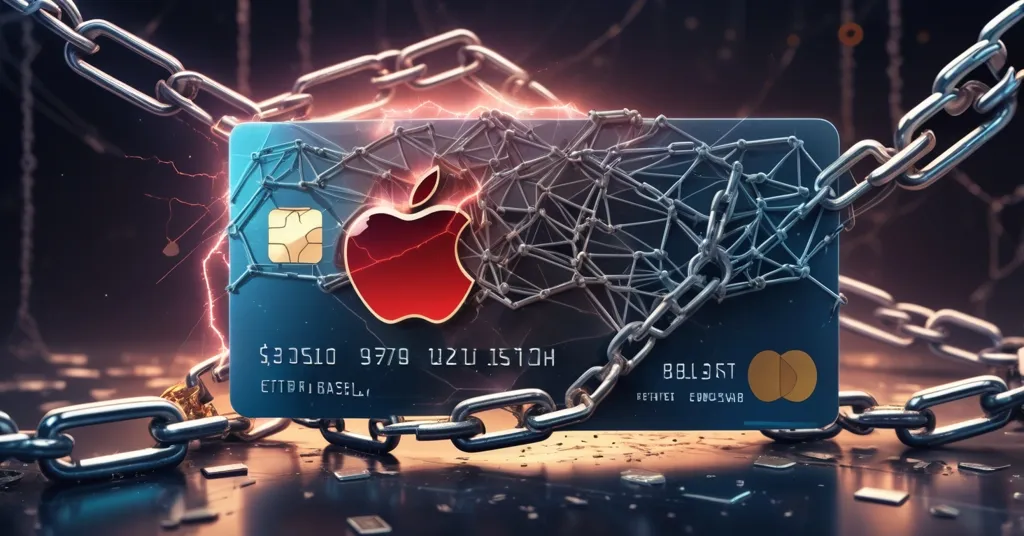JPMorgan to Rescue Apple Card: Is Blockchain a Better Solution?

JPMorgan Eyes Apple Card Rescue: Can Blockchain Offer a Better Path?
JPMorgan is deep in negotiations to take over the Apple Card program from Goldman Sachs, a partnership with Apple that’s been a spectacular mess since its 2019 launch, riddled with technical failures, over $89 million in regulatory fines, and staggering financial losses. As centralized finance trips over its own feet, it’s worth asking: could decentralized systems like blockchain provide a sturdier foundation for the future of money?
- Ongoing Talks: JPMorgan is pushing to replace Goldman Sachs as Apple Card’s financial backbone, though no deal is sealed.
- Goldman’s Collapse: Billions in losses, tech glitches, and hefty penalties have forced Goldman to abandon ship.
- Blockchain Contrast: Centralized failures highlight the potential of decentralized finance (DeFi), despite its own hurdles.
Apple Card’s Downfall: A Centralized Trainwreck
Back in 2019, the Apple Card debuted with all the polish you’d expect from a tech giant like Apple. Integrated seamlessly into the iOS ecosystem, it dangled perks like no annual fees, daily cashback, and interest-free financing for Apple products through its Monthly Installments plan. Paired with Goldman Sachs, a Wall Street behemoth trying its hand at consumer banking, it was pitched as a game-changer. But the shine wore off faster than a cheap knockoff. Goldman, inexperienced at handling millions of everyday users, botched the rollout with technical hiccups—think apps crashing and payments not processing. Customer service was a nightmare, with users left hanging for answers. Worse, early allegations of algorithmic bias surfaced, where the system seemed to unfairly judge creditworthiness based on flawed data or hidden assumptions, sparking outrage and scrutiny.
The card’s rapid adoption, often by customers with lower credit scores, piled on more pain. Goldman had to stash away huge sums as loan loss reserves—basically a financial cushion for loans that might never be repaid—especially as recession whispers grew louder. What started as a glossy fintech experiment turned into a textbook flop, exposing the raw underbelly of centralized financial innovation when it’s rushed out the door without proper guardrails. For more background on this troubled partnership, check out the detailed history of Apple Card issues.
Goldman’s Retreat: Billions Burned and Trust Torched
By 2024, the cracks in the Apple Card partnership had widened into a chasm. The Consumer Financial Protection Bureau (CFPB), a U.S. government agency tasked with shielding consumers from shady financial practices, dropped a bombshell. They slapped Goldman Sachs and Apple with penalties totaling over $89 million—$45 million in fines plus $19.8 million in customer restitution for Goldman, and a $25 million fine for Apple. The accusations were damning: misleading users about interest-free payment plans and fumbling dispute resolutions so badly that customers were left stranded. CFPB Director Rohit Chopra didn’t hold back, tearing into both companies for their arrogance and negligence.
“Apple and Goldman Sachs illegally sidestepped their legal obligations for Apple Card borrowers. Big Tech and Wall Street firms should not behave as if they are exempt from federal law.”
Chopra called the launch “chaotic,” pointing out that essential systems weren’t even functional at rollout. He also revealed that Goldman ignored third-party warnings about flaws in their dispute resolution setup, a screw-up that cost users dearly. Internally, Goldman was bleeding—reports peg their consumer banking losses at over $6 billion. That’s not a rounding error; it’s a crater even Wall Street can’t patch over. Despite a contract locking them into the Apple deal until at least 2029, Goldman under CEO David Solomon has been scrambling to escape, even offloading other consumer ventures like their General Motors credit card business to Barclays. As of March 2024, they’re still saddled with $20.5 billion in credit card loans, a nagging reminder of their misstep into uncharted territory. For deeper insights into the regulatory actions, see the CFPB’s findings on Goldman Sachs penalties.
JPMorgan’s Gambit: Savior or Next in Line to Stumble?
With Goldman desperate to bail, JPMorgan has stepped into the ring as the leading contender to take over Apple Card. As the largest U.S. credit card issuer by purchase volume, with their Chase brand a household name, they’ve got the muscle and know-how to manage a high-profile program like this. Competitors like American Express, Synchrony, and Barclays have all bowed out, leaving JPMorgan as the last bank standing. But they’re not diving in headfirst with blind optimism. They’re demanding changes to the card’s structure, starting with scrapping the calendar-based billing system—where statements are tied to a user’s signup date—in favor of uniform monthly cycles starting at the beginning of each month for clarity and consistency. They’re also pushing to buy the loan portfolio at a discount, a hard-nosed move acknowledging the existing losses tied to the card’s riskier customer base.
JPMorgan’s track record offers some hope. Their Chase cards consistently rank high in customer satisfaction, and their infrastructure is battle-tested compared to Goldman’s shaky setup. But let’s not get starry-eyed—there’s real risk here. They could inherit a toxic mess of loans and a tarnished brand. Apple’s ecosystem lock-in, with tight integration into Apple Pay and iPhones, might still drive adoption, but user trust took a hit with that $25 million fine and the stink of misleading marketing. Can JPMorgan turn this around, or are they just signing up for round two of a beautifully designed disaster? Their push for control over terms suggests they’re at least aware of the landmines—whether they can dodge them is another question. For the latest on these negotiations, take a look at updates on JPMorgan’s potential takeover.
Decentralized Dreams: Could Blockchain Rewrite the Rules?
Zooming out from the Apple Card soap opera, this whole fiasco screams one thing: centralized systems can buckle under their own weight when mismanagement creeps in. For those of us who live and breathe disruptive tech, it’s hard not to draw parallels to decentralized finance, or DeFi. If you’re new to the term, DeFi refers to financial systems built on blockchain technology—think Bitcoin or Ethereum—where there’s no middleman like a bank. Instead, transactions and agreements are handled by code, often through smart contracts, which are self-executing deals hardcoded on networks like Ethereum. The appeal? Transparency and user control. Every move is logged on a public ledger, making it damn near impossible to hide screw-ups like Goldman’s dispute resolution disasters.
Imagine a credit system on the blockchain: no opaque algorithms spitting out biased credit limits, no delayed disputes buried in corporate red tape. Real-world projects like MakerDAO, which lets users borrow against crypto collateral, or Aave, a lending platform, already prove the concept isn’t just sci-fi. Now, I’m not saying DeFi is ready to replace Visa or Mastercard tomorrow—let’s be real. Hacks, scams, and a Wild West lack of regulation are massive hurdles. Just look at the billions lost to DeFi exploits in recent years. And yet, when you stack that against Goldman’s $6 billion black hole or the CFPB’s findings of systemic negligence, the decentralized ethos starts looking less like a pipe dream and more like a viable experiment. Curious about how blockchain stacks up against traditional systems? Explore some perspectives on blockchain versus banking systems.
Tying this to our roots, Bitcoin stands tall as a store of value, a hedge against the instability of centralized financial giants tripping over their own hubris. Meanwhile, altcoins like Ethereum fuel DeFi innovation with smart contracts that could one day underpin credit systems far removed from Wall Street’s clutches. Even JPMorgan isn’t blind to this—they’ve been tinkering with blockchain through their Onyx platform for tokenized payments. Could we see hints of that tech seep into Apple Card down the line? It’s a long shot, sure, but in a landscape where stablecoins are eyed as alternatives to traditional banking woes, it’s not entirely off the table. Learn more about potential intersections in JPMorgan’s blockchain initiatives and Apple Card.
What’s Next for FinTech Disruption?
As JPMorgan inches closer to a deal, the Apple Card’s future hangs in the balance. If they pull it off, they might restore some stability to a product that promised the moon but delivered migraines. But let’s not pretend credit card partnerships, even with a shiny Apple logo, are free of baggage. Apple’s brand has taken a dent—will users still trust Apple Pay or future financial tools after being misled on payment plans and slapped with a $25 million fine? And for JPMorgan, the question looms: can traditional finance ever truly innovate without repeating these same centralized pitfalls? For a deeper dive into the financial losses and fines, see details on Apple Card’s regulatory penalties.
For those rooting for real disruption, this saga is a glaring neon sign. While Big Tech and Wall Street bicker over who gets to hold the broken pieces, Bitcoin, Ethereum, and the broader blockchain space are quietly building a parallel economy. Maybe the true revolution isn’t in a titanium credit card, but in code that doesn’t bow to boardrooms. Time will tell if JPMorgan can prove the skeptics wrong—or if they’re just the next to learn a very expensive lesson. Community reactions to these developments are heating up; check out discussions on JPMorgan’s takeover talks or explore user frustrations in threads about Goldman’s exit challenges.
Key Takeaways and Questions
- What drove Goldman Sachs to ditch the Apple Card?
Over $6 billion in losses, crippling tech failures, and $89 million in fines for misleading customers and botched dispute handling made the partnership untenable. - Why is JPMorgan the frontrunner to take over?
As the top U.S. credit card issuer, their experience and infrastructure dwarf competitors like American Express, who’ve dropped out. - What broke Apple Card under Goldman’s watch?
A chaotic launch with broken systems, misleading payment info, and delayed disputes led to consumer distrust and regulatory penalties. - How might blockchain outshine traditional credit systems?
Decentralized finance offers transparency and cuts out middlemen, avoiding centralized mismanagement, though risks like hacks remain. - Could JPMorgan’s blockchain efforts tie into Apple Card?
Their Onyx platform for tokenized payments hints at potential innovation, but any integration is speculative for now.



